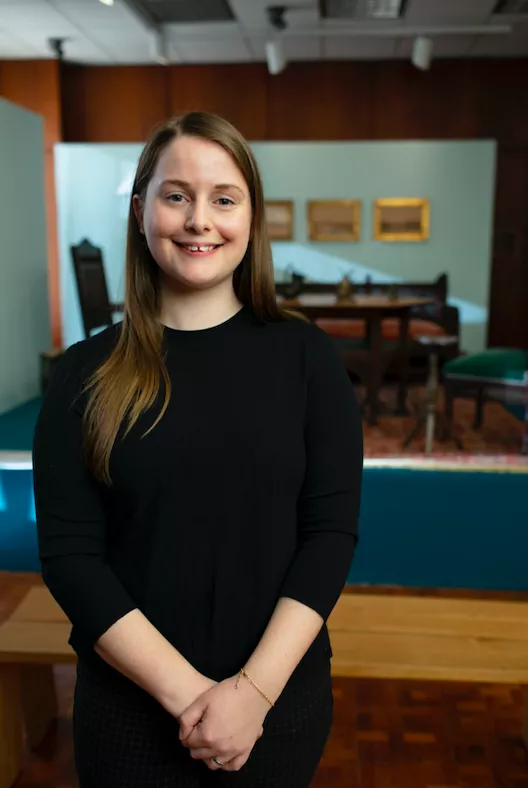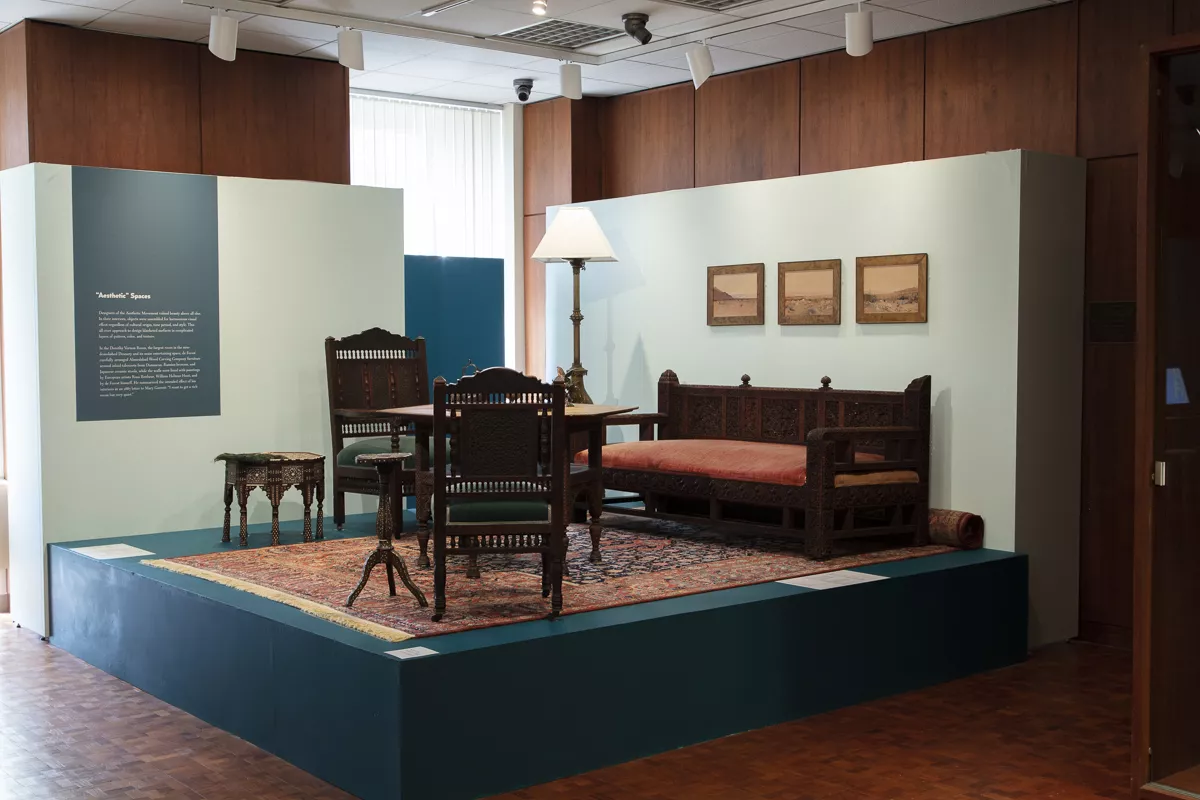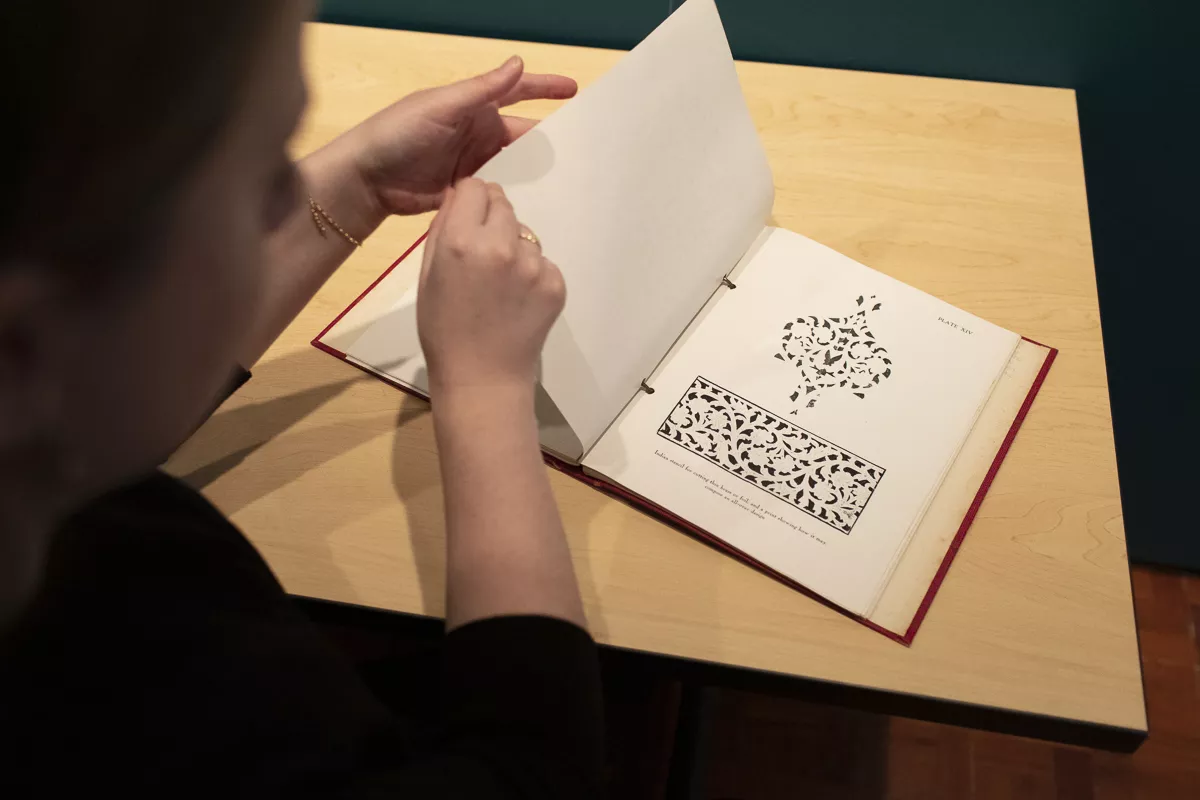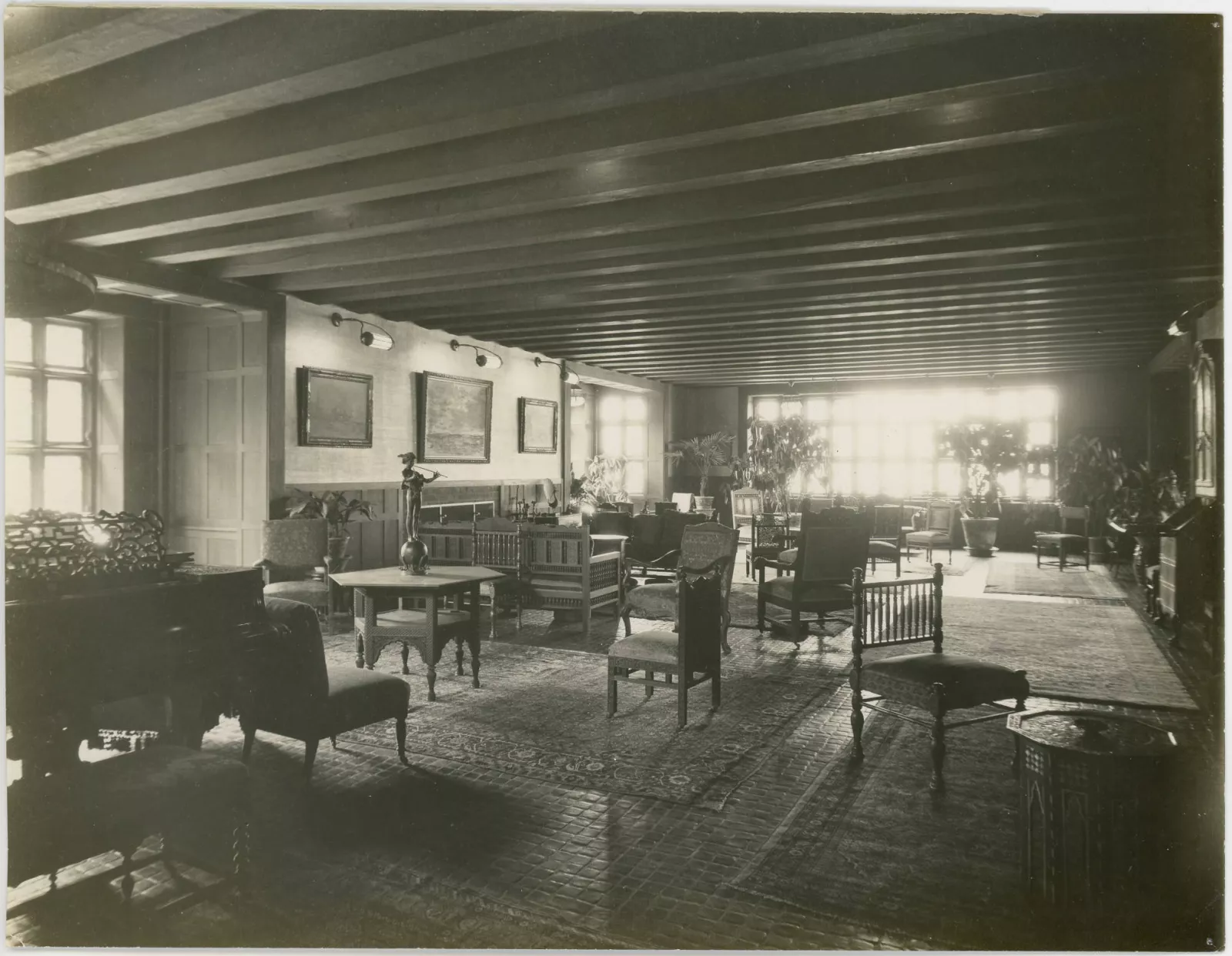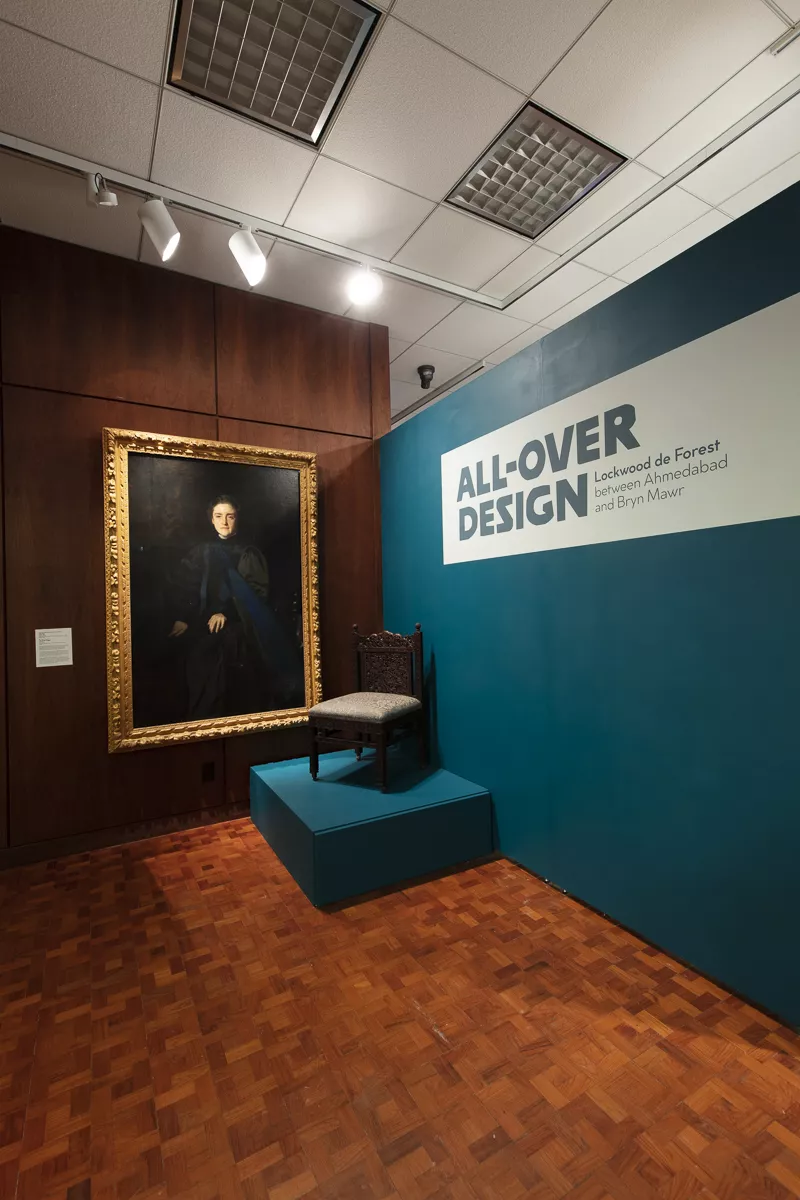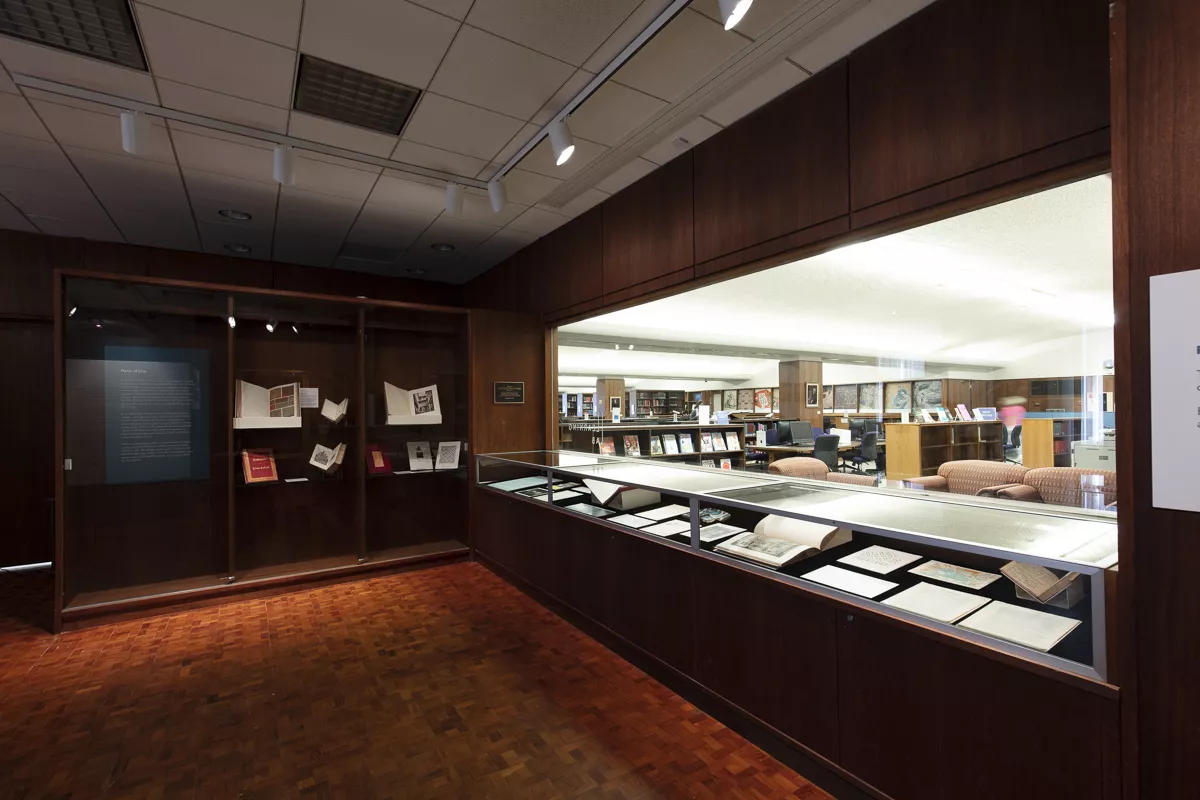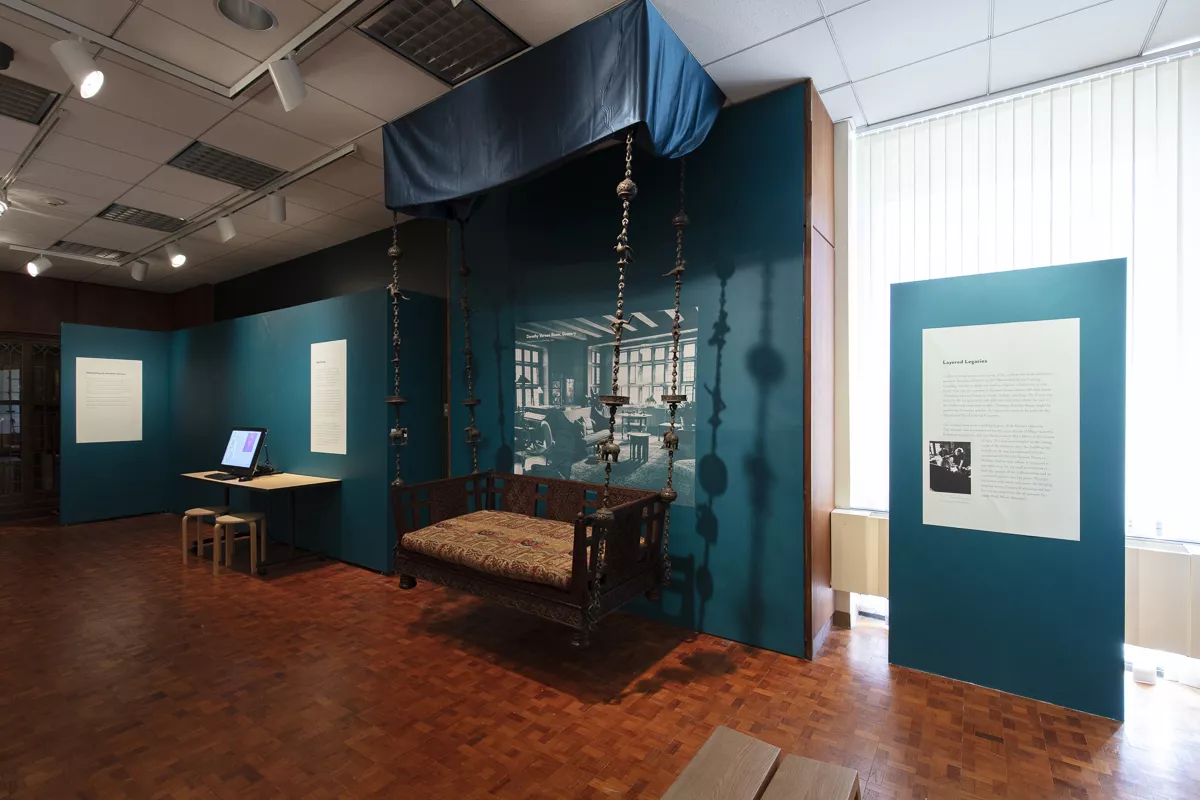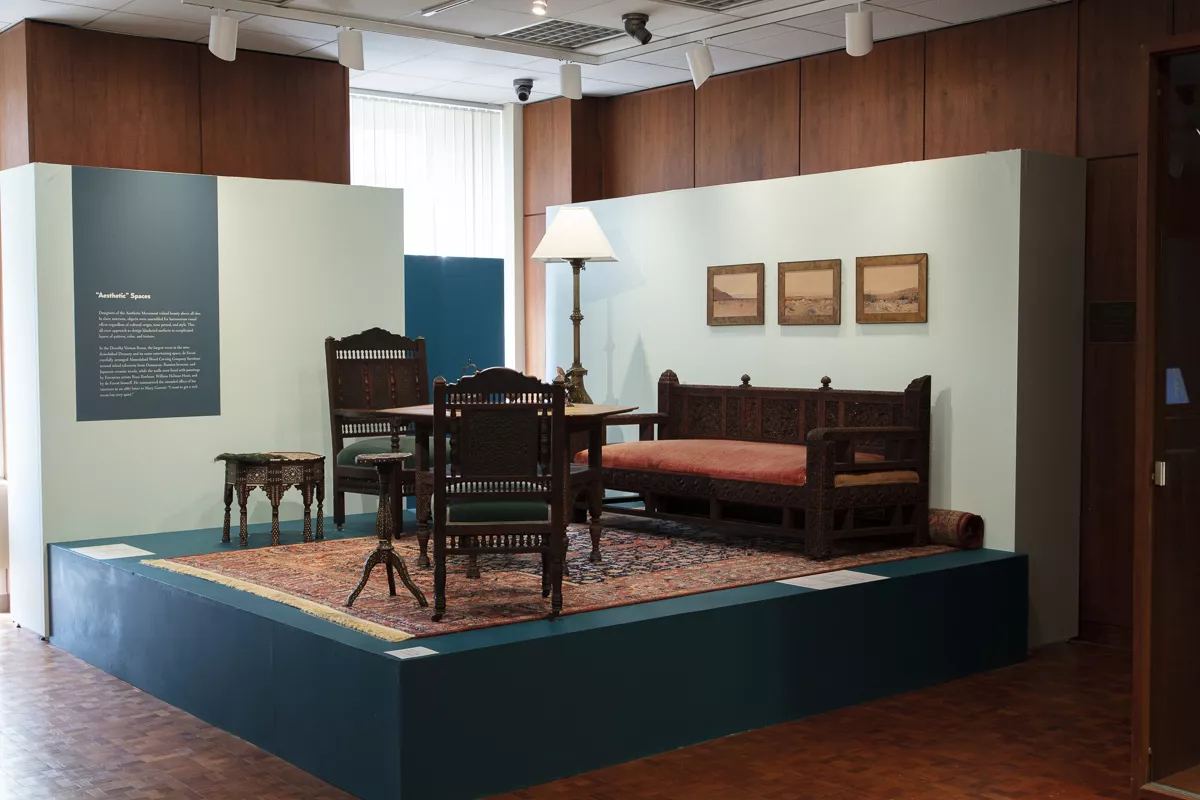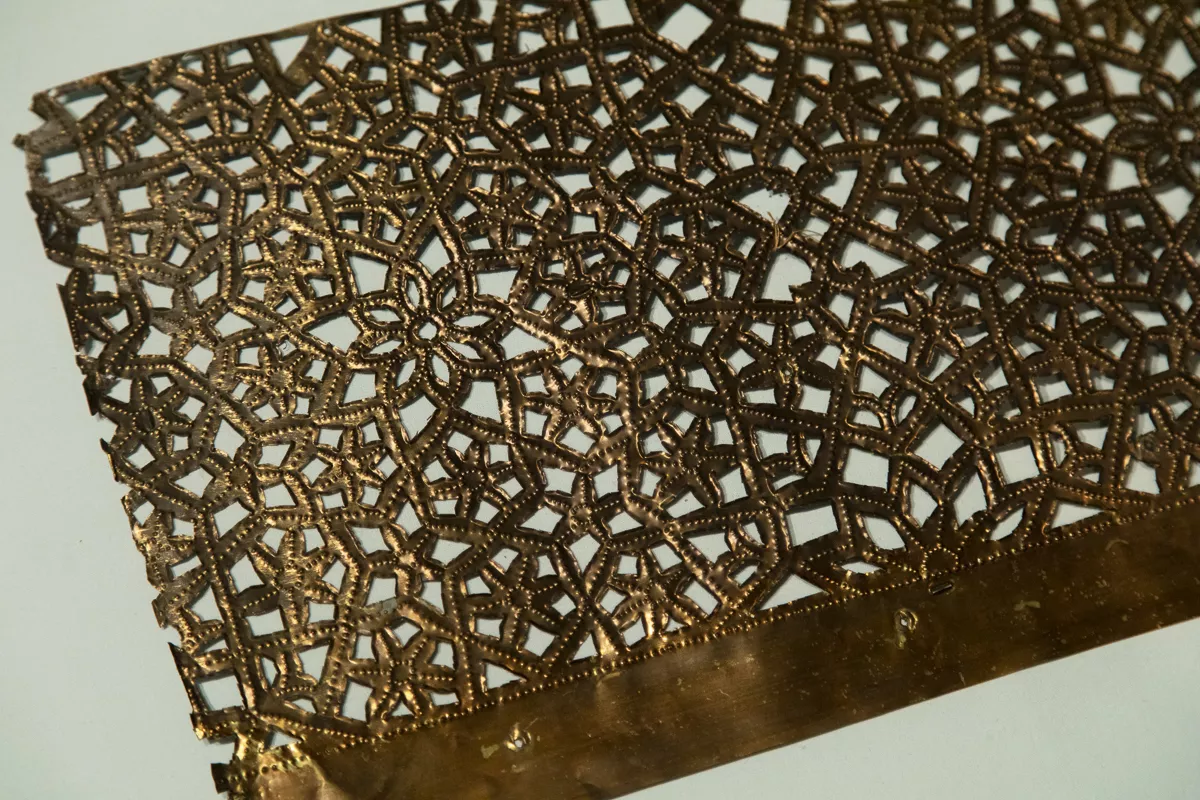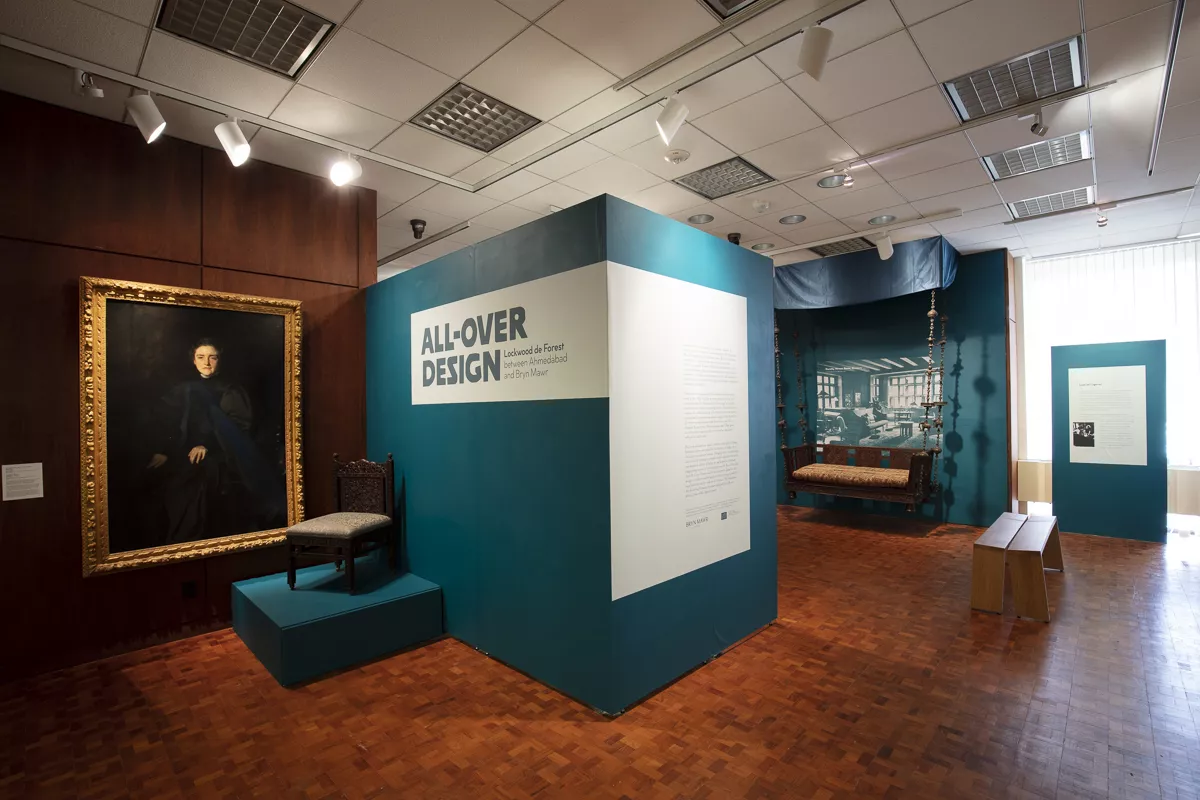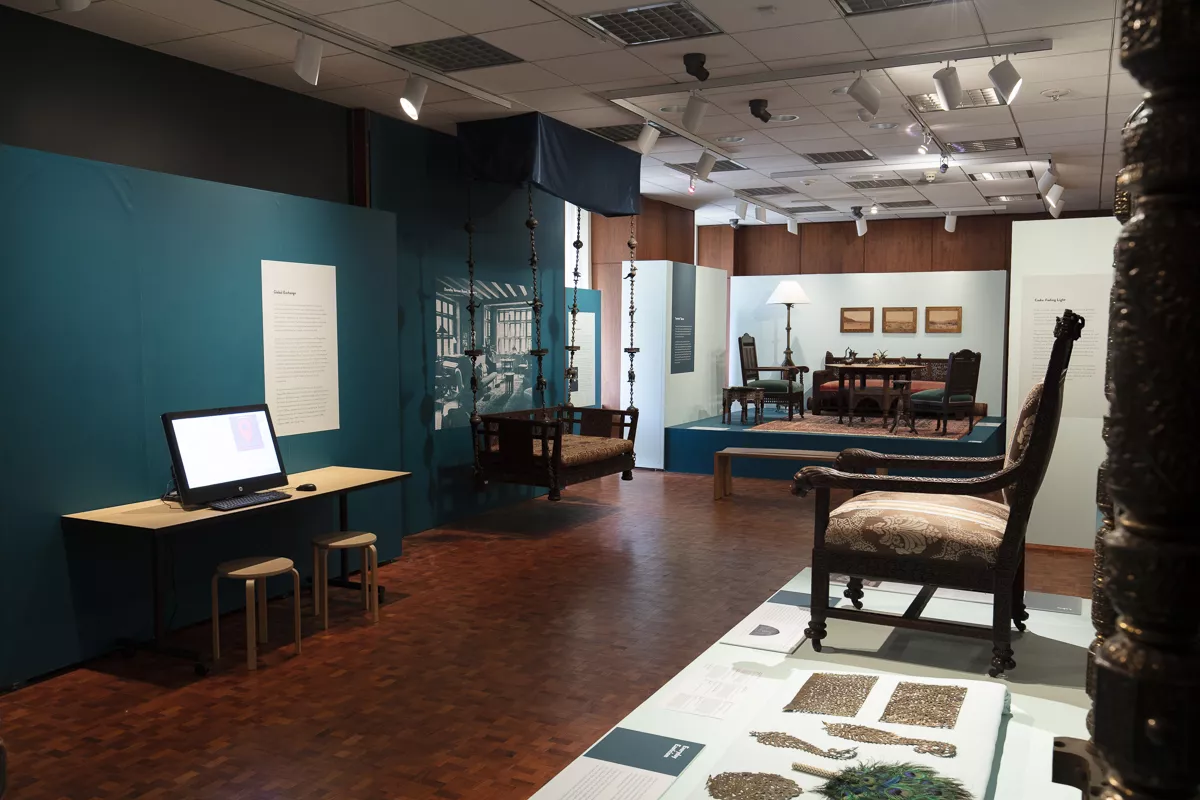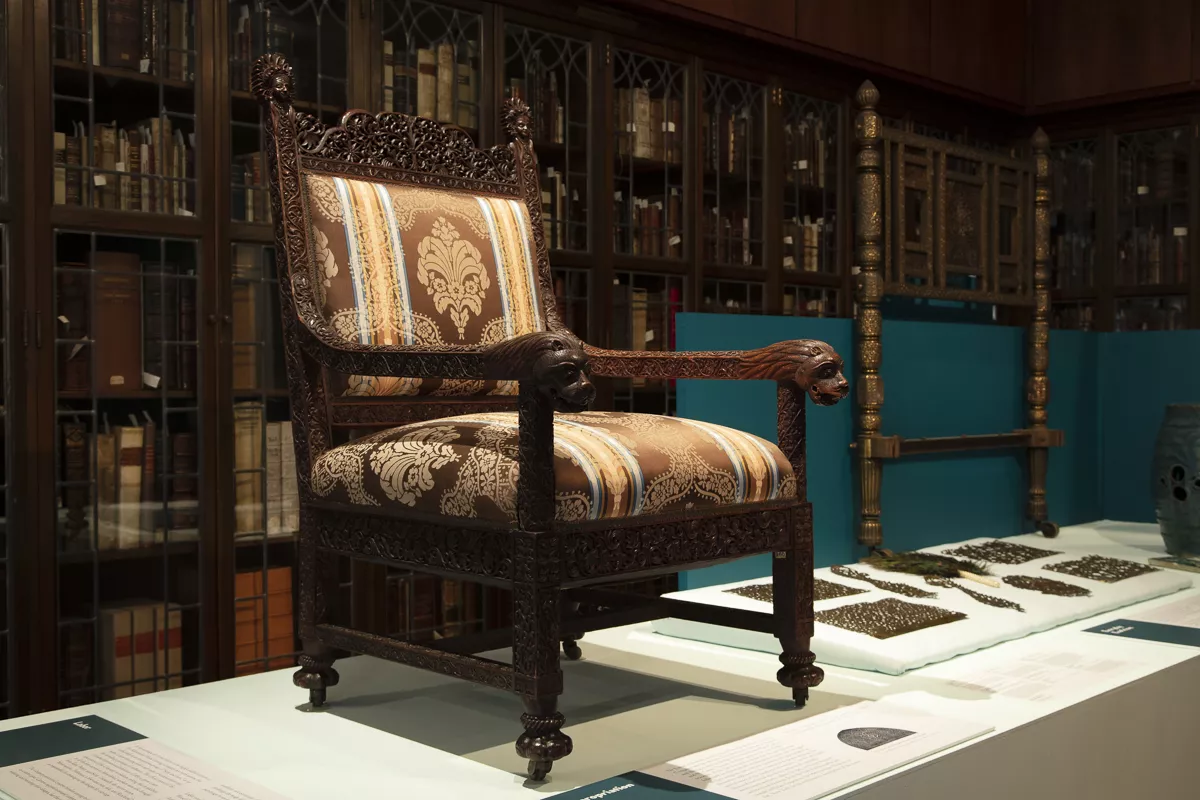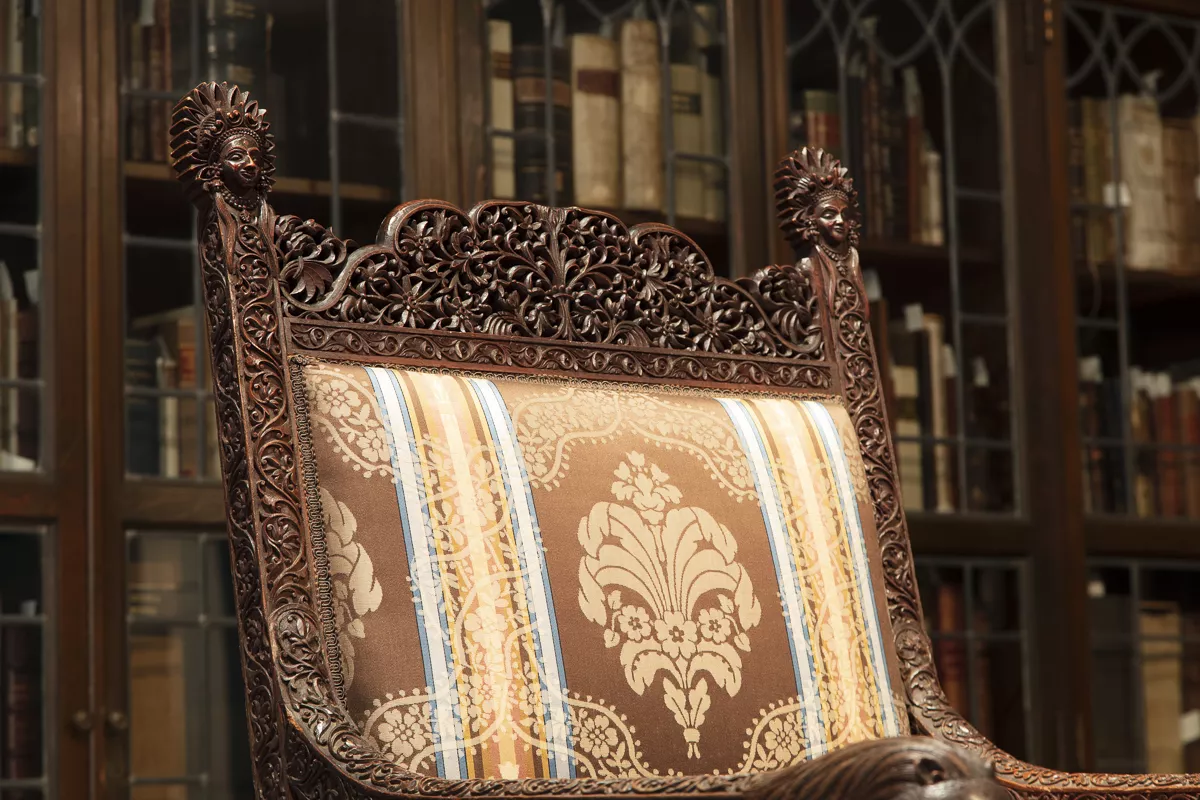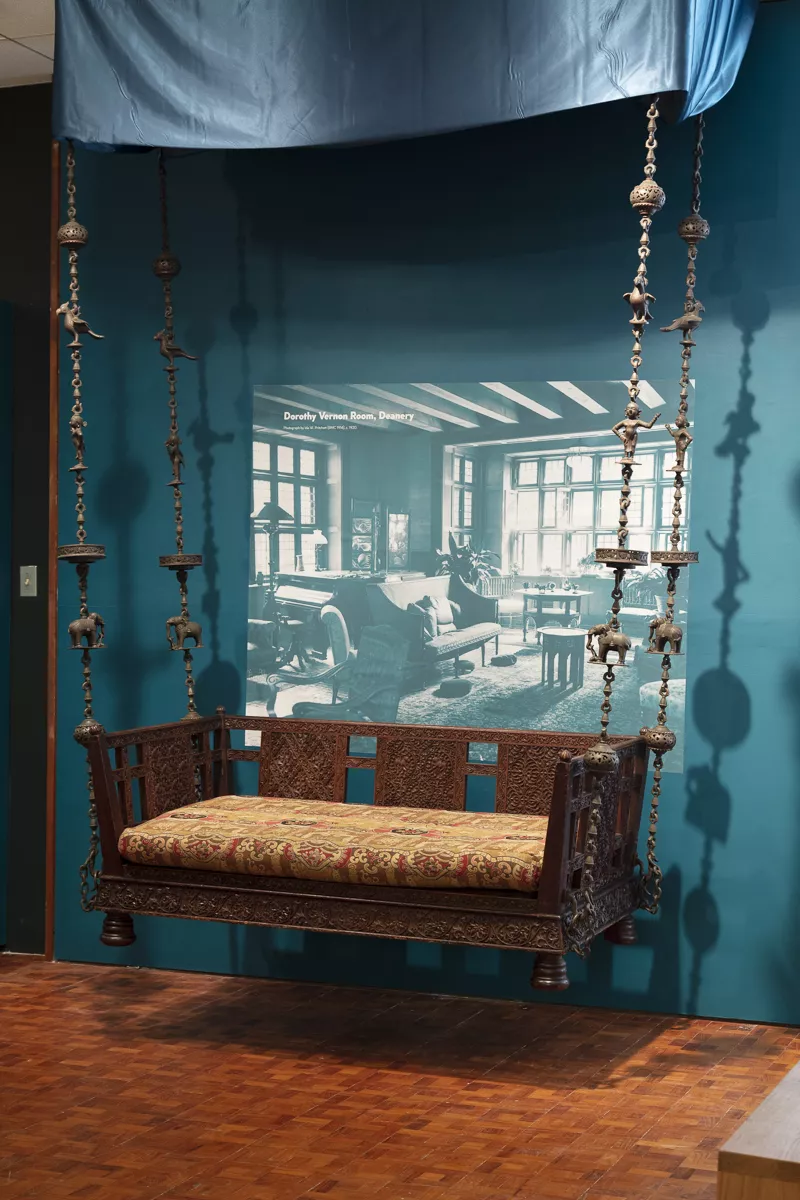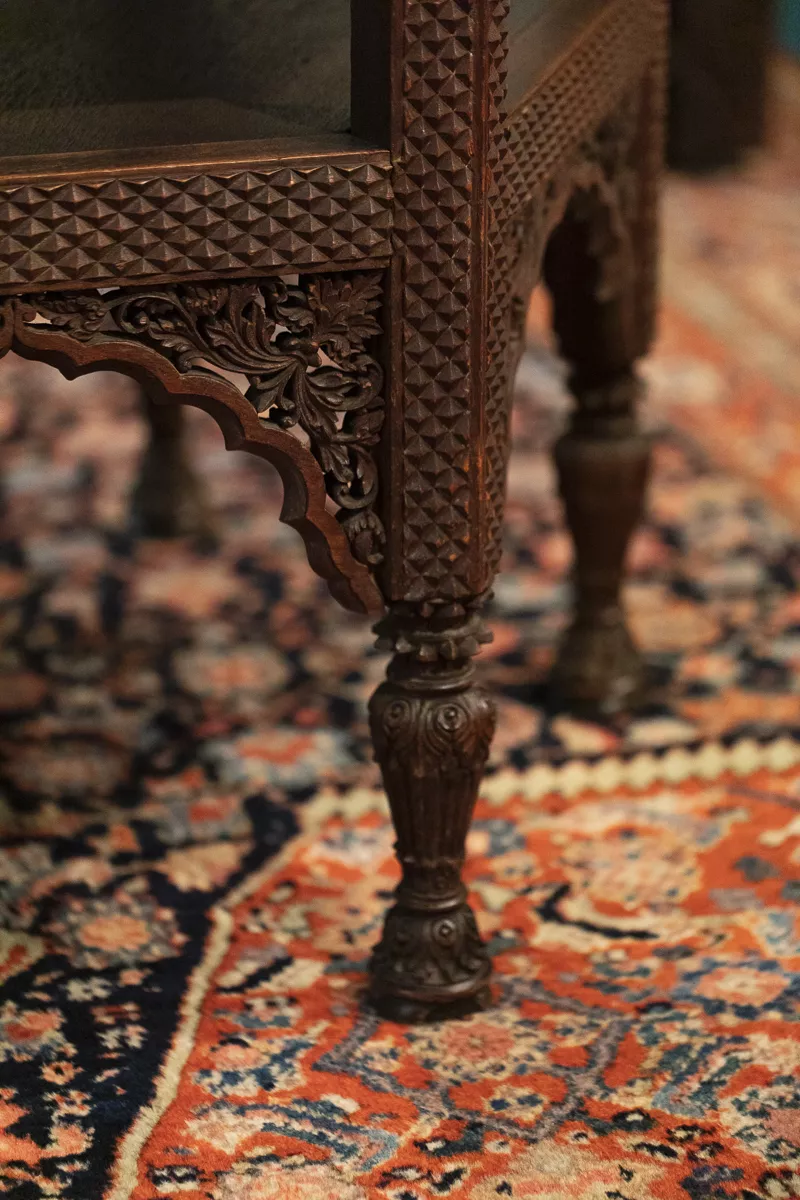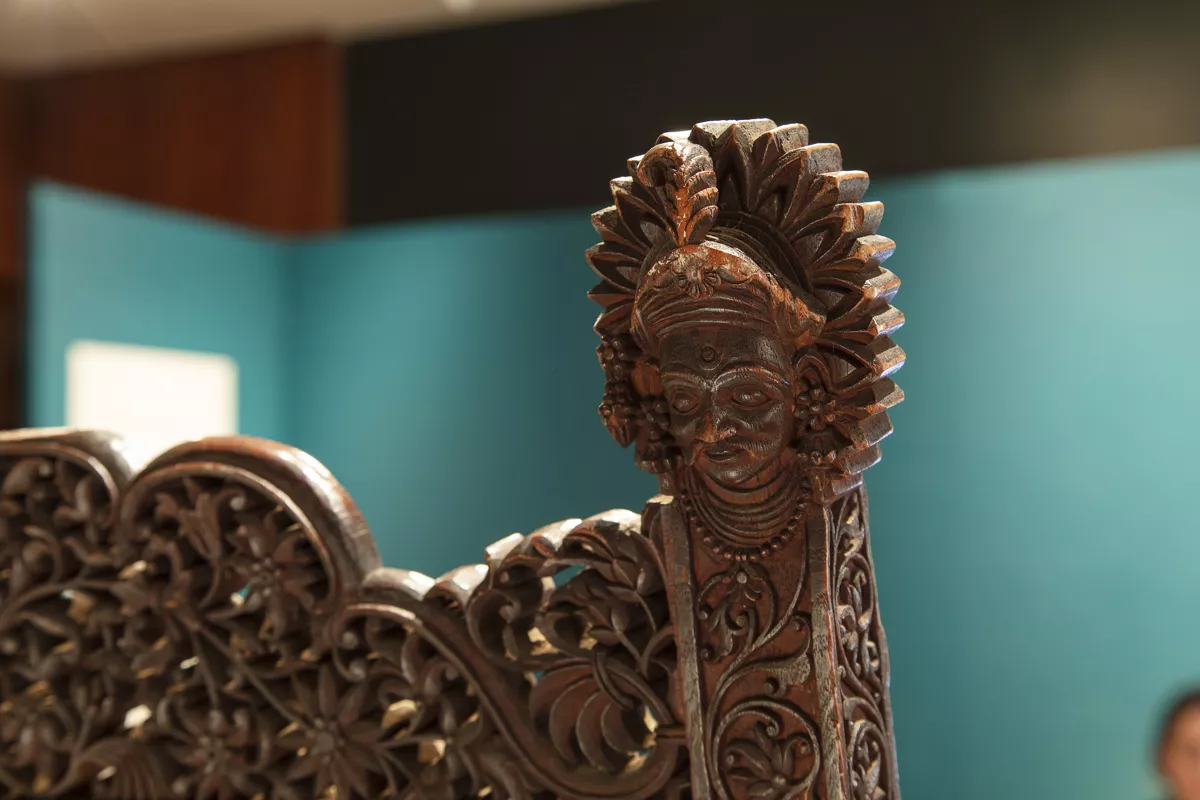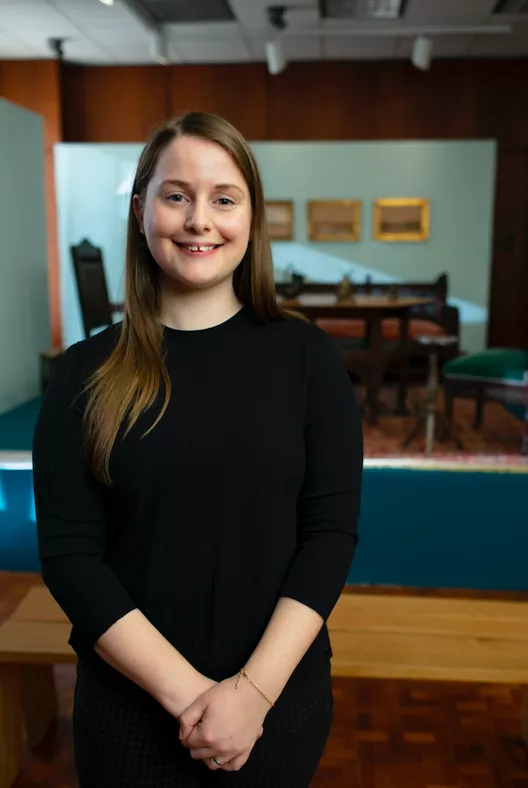'All-Over Design' and the complicated life of Bryn Mawr's Lockwood de Forest collection

Nina Blomfield, Ph.D. Candidate in History of Art and curator of the recent exhibition "All-Over Design": Lockwood de Forest between Ahmedabad and Bryn Mawr spoke with us about the formation of the Ahmedabad Wood Carving Company, Lockwood de Forest's complicated relationship with Bryn Mawr College, and bringing the de Forest collection together again.
In "All-Over Design": Lockwood de Forest between Ahmedabad and Bryn Mawr, Nina Blomfield (Ph.D. Candidate, History of Art) has drawn together a collection of furniture and decorative arts rarely seen together since Bryn Mawr College’s Deanery was demolished in 1968. The exhibition, which ran from October 24 until March 1 in the Rare Book Room of Canaday Library, was the first exploration of Bryn Mawr’s collection that focused on the work of the Ahmedabad Wood Carving Company and Lockwood de Forest, a landscape painter, designer and architect working in late nineteenth-century New York. It was in the Deanery that the furniture was once displayed as part of the broader personal art and object collection belonging to M. Carey Thomas. Nina’s curatorial vision for “All-Over Design” uses these objects to narrate the complicated cultural interactions between Lockwood de Forest, former Bryn Mawr College president M. Carey Thomas, and the anonymous wood carvers in the employ of de Forest’s Ahmedabad Wood Carving Company.
Lockwood de Forest is primarily known for his output as a landscape painter. De Forest was a peripatetic artist, traveling across the Americas, Europe, the Middle East, and North Africa using oil paints to capture subtle views of coasts and plains awash in sunlight. However, his marriage to Meta Kemble of the du Pont family and business partnerships with Louis Comfort Tiffany, Samuel Colman, and Candace Wheeler, brought him to India for travel and to procure objects of Indian craftsmanship for display in America and England – and eventually for sale to wealthy Gilded Age patrons such as Andrew Carnegie, Potter Palmer, Mark Twain, Mary Garrett, and her friend M. Carey Thomas.
In 1881, de Forest established the Ahmedabad Wood Carving Company in Ahmedabad, Gujarat with Indian philanthropist and art patron Muggunbai Hutheesing. Nina notes that the partnership was one rooted in a deep friendship between de Forest and Hutheesing. Hutheesing’s cultural capital as civic leader and religious benefactor in Ahmedabad enabled access to traditional systems of patronage required to hire artisans, while the Ahmedabad Wood Carving Company also depended on de Forest’s ability to secure an American clientele for its products. Though mutually beneficial, this partnership was also unequal, inflected by the social, cultural, and racial hierarchies that supported the colonial system.
Yet, de Forest’s motivations in the success of the Ahmedabad Wood Carving Company extended beyond economics. De Forest was struck by the immersive visual experience of elaborately carved teakwood ornamentation adorning the homes and mosques of Indian cities. He quickly developed a belief in the superiority of Indian craftsmanship and aesthetics over Western art. As curator, Nina deliberately sought to draw attention to the complicated relationship between Lockwood de Forest, his idealization of South Asian art, and carvers in his employ. De Forest believed that Indian craftsmen had an innate mastery over woodcarving – somehow inherent, subconscious, and biological. While misguided in his beliefs about the transmission and origins of cultural knowledge, his view meant that creative authority over furniture design was invested to the carvers in his company. He comments in his own writings that the craftsmen in his employ “have perfected the art of line more than anyone in the West could ever do, the East is where art has been brought to perfection.” His perception of the local craftsmen is truly reflective of nineteenth-century colonial ideology – a Romanticized orientalism in which the East is the source of beauty and perfection, and an understanding of culture derived from contemporary anthropology in which cultural traits are geographically fixed, racial, and inherited through the blood and spirit of races.
For Nina, one of the difficulties in curating “All-Over Design” was deciding who to credit on object labels. De Forest’s writings show that he regarded the Ahmedabad Wood Carving Company carvers as highly skilled designers, who were able to produce intricate carvings autonomously and without reference to predetermined plans. Yet since he also never names the carvers, their individual identities have been lost. Nina felt that giving de Forest sole credit for many of the objects in Bryn Mawr’s collection would be a re-enactment of this erasure. Instead, each object label reads “Made by the Ahmedabad Wood Carving Company” – to shift the balance, acknowledge the collective production of these objects, and to highlight de Forest’s role more as broker or middleman in an exchange of objects between India and the United States.
How did Bryn Mawr come to acquire so much furniture of the Ahmedabad Wood Carving Company? Well-connected through both social and artistic circles, Lockwood de Forest was a friend to many wealthy Gilded Age elites, including M. Carey Thomas and suffragist Mary Garrett. The two even rented an apartment in the Ava Apartment building, next door to de Forest’s midtown Manhattan home. Together, Thomas and Garrett collected many pieces from de Forest’s company and furnished the Deanery with an eclectic collection of objects of art and craft. Even further, Thomas and Garrett used their social connections to design Bryn Mawr’s buildings and campus layout – employing Fredrick Law Olmstead for many exterior spaces and plan, and eventually de Forest for building exteriors and interiors.
De Forest was introduced by M. Carey Thomas to Bryn Mawr’s Alumni Commission that was ultimately responsible for contracting interior design work for the Great Hall. When the original architects of the Great Hall, Cope and Stewardson, failed to provide interior designs within the College’s budget, the firm was dismissed, and Lockwood de Forest completed the designs at a significantly cheaper rate. De Forest’s richly patterned design still adorns the ceiling and beams of the Great Hall and its staircase. Nina has shown that the designs were likely a collaboration between De Forest and Thomas, a hybrid of his interest in Gujarati stencilwork and her love of English country manors.
It is Lockwood de Forest’s work with Bryn Mawr College that piqued Nina’s interest in late nineteenth-century exchange between India and America. Her project began as a research paper for the 2017 graduate seminar “Principles of Preservation and Conservation of Cultural Heritage” co-taught by Associate Professor Astrid Lindenlauf, Chair of the Department of Classical and Near Eastern Archaeology, and Marianne Weldon, Collections Manager of Special Collections. There Nina recognized how de Forest’s vision as an artist and architectural designer was fully embedded in the aesthetic fabric of Bryn Mawr’s campus. In addition to decorating the Deanery and the Great Hall, de Forest was also the principle architect of the former college gymnasium (now the Marie Salant Neuberger Centennial Campus Center) and the Health and Wellness Center. He provided designs for everything from lampposts to the library bookplate, the Denbigh bench, and the Cloister fountain.
Nina feels that curating “All-Over Design” meant that it was important to help viewers understand the context of each object - and the ways they were used and experienced in their historical past. “For me this meant trying to find a way to reconstruct that experience through the period room, while also being conscious of not reiterating the aspects that are problematic about that – seeing things as aesthetic and not understanding their cultural origins. In the exhibition I tried to do both – to have the period room to give the viewer an understanding of how these objects were used and understood, but then to pull that apart and look at things closely to give an understanding of the issues surrounding them – colonialism, labor exploitation, and the way objects were devalued and dispersed across Bryn Mawr’s campus.”
Pulling apart the contexts of the collection meant expanding the programming for “All-Over Design” beyond the exhibition and into Bryn Mawr Special Collections “Friday Finds” series of lectures. Kicking off the exhibition was an October 24 lecture by leading de Forest scholar Roberta Mayer on "Lockwood de Forest at Bryn Mawr College: Exoticism and Eclecticism." On November 8, Nina and colleague Katie Loney, Ph.D. student at the University of Pittsburgh, hosted the object study day which offered an up-close view of the Ahmedabad Wood Carving Company furniture. “Friday Finds” continued with presentations from Bryn Mawr Cities professor Jeffrey Cohen, art advisor and appraiser Molly Seiler (BMC ’83), and William Coleman (HC ’07), Director of Collection & Exhibitions at the Olana Partnership. Programming for the exhibition concluded with a student symposium on February 21, featuring a series of undergraduate and graduate student talks and a keynote presentation from Sylvia Houghteling, Assistant Professor of History of Art at Bryn Mawr College.
The exhibition was accompanied by an online interactive digital map of the international impact of Lockwood de Forest and the Ahmedabad Wood Carving Company, which was researched and assembled entirely by Bryn Mawr undergraduate Rachel Grand (BMC ’21) as part of a BMC Praxis Internship. Rachel also curated the simultaneous exhibition Bauhaus at Bryn Mawr: Marcel Breuer’s Furniture for Rhoads currently on display on in the Coombe Suite Display Case on the second floor of Canaday Library. Bauhaus at Bryn Mawr tracks the history of the furniture designed by Marcel Breuer for Rhoads Hall and explores how high design continued to play an important role in life at Bryn Mawr College.
“All-Over Design”: Lockwood de Forest between Ahmedabad and Bryn Mawr was curated by Nina Blomfield in coordination with Curator/ Academic Liaison of Art and Artifacts Carrie Robbins. The exhibition was made possible by Friends of the Library Graduate Internship in summer of 2019.

